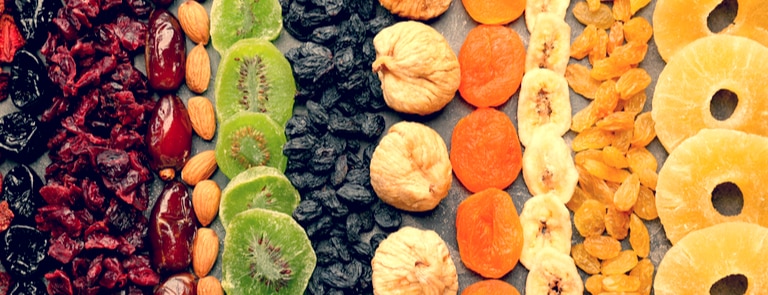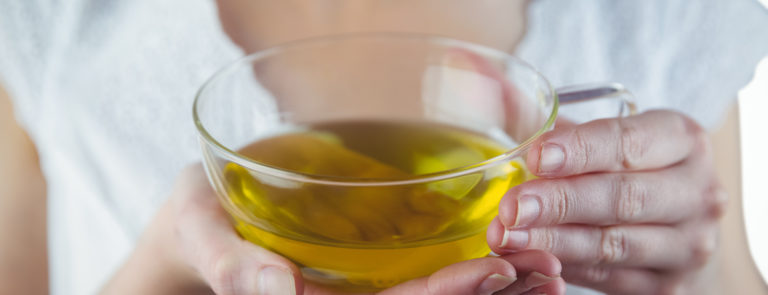15% off €25
The truth about dried fruit

Whether sprinkled on top of your favourite cereal or enjoyed on the go as a healthy snack, dried fruit is a great way to get those all-important nutrients in your diet. Plus, they taste delicious too.
However, dried fruit has a bit of a reputation. In recent years, the dried fruit market has been in decline, with many misconceptions driving us to choose other snacking options instead.1
The truth is, there are many health benefits to eating dried fruit, but there are some considerable differences in nutritional value when compared to fresh fruit.
In this article we’ll go over the benefits of dry fruits, the differences in nutrition and bust any myths or misunderstandings about adding dried fruit to your diet.
Is dried fruit bad for you?
First things first, the biggest question is, is adding dried fruits and dried berries into your diet bad for you?
Unfortunately, it’s not quite as simple as that.
As with lots of foods, dried fruit can have both positive and negative effects on your diet.
On one hand, dried fruit can improve the quantity of fibre and nutrients you get in your diet. However, dried fruits also contain large amounts of sugar and the number of calories in dried fruits is often higher.
For this reason, dried fruits should be eaten in small amounts, as part of a balanced diet.
Summary
- Dried fruit is high in fibre and nutrients, but it also contains large amounts of sugar and a high number of calories.
What is dried fruit?
Dry fruits are basically fruit that has had nearly all of its water content removed.
Fruit is either dried naturally, through sun drying, or through a specialised dehydrator which shrinks the fruit, leaving behind a small, energy-dense dried fruit.
Subsequently, dried fruit has been a popular tradition for thousands of years - due to its sweet taste, nutritive value, and long shelf life.
Traditionally, dried fruit that does not contain added sugars or juices is known as ‘conventional’ dried fruit. This is because they are produced by merely removing the water from fresh fruit without any added sugars.2
Summary
- Dried fruit is fruit that has had nearly all of its water content removed
- Fruit is dried either naturally, through sun drying or a specialised dehydrator
- Dried fruit has been popular for thousands of years – mainly due to its long shelf life
Which dried fruits are healthiest?
It’s a good idea to choose dried fruit with no added sugars. These will likely give you the most health benefits without bringing too much unnecessary sugar into your diet.
For very tart dried fruit options, like cherries, you could look for products that are naturally sweetened with juice before drying as a healthier alternative.3
All dried fruit typically provides essential micronutrients and fibre. However, some of the healthiest options include: link to products
-
- Figs
- Prunes
- Apricots
- Raisins
- Dates
- Goji berries
- Cranberries4,5
However, you might want to do more research into the different types of dried fruit to find an option that works for you. You don’t have to stick to one fruit either. Mixing and matching your fruit will give you a range of essential nutrients when enjoyed as a part of a balanced diet.
Summary
- Choose dried fruit that do not contain added sugars
- There are many types of dry fruit, so its ideal to research which works best for you
Benefits of dried fruits
The key to getting the most nutritional benefit from dried fruit is choosing the right type. Most traditional dried fruits are made by removing the water from the fresh fruit. The result is simply a dried version of fresh fruit, with no extra sugar or other ingredients added.6
Some methods involve adding extra sugar prior to the drying process or candying once the fruit has been dried. Added sugar can make the nutritional profile of your chosen fruit a lot more calorific, so it’s worth checking the calories in dried fruit by looking at the ingredients and the nutrition information before you buy.
Top 3 benefits of dried fruit
-
More fibre
Dried fruits tend to have more fibre than their fresh relatives, making them a great choice for those wanting to get more fibre into their diet.
-
Antioxidants
Most dried fruits include more phenols than fresh alternatives, which may contribute to a reduced risk of heart disease, diabetes, and other health conditions.
-
Vitamins and minerals
As a concentrated version of fresh fruit, dried varieties often have higher levels of essential micronutrients (except for vitamin C).7
It’s worth bearing in mind that dried fruit is much more concentrated when compared with fresh fruit. That means you’ll need to watch your portion size, as these snacks are notoriously easy to overeat.8
Summary
- The benefits of eating dried fruit include: more fibre, could reduce risk of health concerns and high levels of vitamins and minerals
Dry fruit v fresh fruit
While fresh fruits have long been considered the best option, dried fruits contain many of the same benefits. Whether it's fresh or dried, fruit is nutritious. Both are packed with vitamins, minerals and fibre, so it’s a difficult one to argue.
In all honesty, it all comes down to moderation.
Is dried fruit healthier?
To put it simply, dry fruit calories might be slightly less in comparison to its volume, however that doesn’t always make it the healthier option.
For example, one plum may have 30 calories, while one dried plum, or prune, may have 23 calories. At face value, it may look like the prune is the better choice. However, when you consider the actual size of a plum versus the shrunken size of the prune, there are different values.
Plums have a lower energy density than prunes. That means they’re low in calories compared to their volume. Prunes, on the other hand, are a high energy-dense food, which also means they’re not as filling.9
When you take raisins and grapes, who each share similar volumes of protein and fat. Raisins contain about 3g of protein and 1g of fat compared to grapes which contain around 1g protein and minimal fat per 100g.
The key difference here is in their carbohydrate content, which is entirely natural sugars. Raisins contain 62g of carbohydrates per 100g compared to grapes which contain just 16g per 100g.10
Yet, when you consider fibre content, which is important addition to your diet in order to support healthy digestion, prunes have 3g per 100g compared to 1g per 100g which is approximately what you’ll find in grapes.11
The result
Dried fruit contains less water and is therefore a more powerful source of nutrients. Healthy dried fruit, which doesn’t contain any added sugars tends to be higher in most vitamins and minerals per 100g. However, dry fruit calories are significantly higher per 100g. So, its up to you to consider which fresh fruits and healthy dried fruit fits best into your diet.12
How much counts as one of you five a day?
In accordance with the NHS, a 30g portion of dried fruit, which is roughly three tablespoons amounts to one of your five-a-day – this is roughly equivalent to 80g of fresh fruit.13
What dried fruit should you avoid?
Many dried fruits are made more appealing, or sweet by being coated with sugar or syrup before going through the drying process. This can also be known as ‘candied’ fruit.
Added sugar, as we’re sure you’ll know, isn’t the best option when eating a balanced diet. In some severe cases it may increase the risk of obesity or heart disease.
In summary
Dried fruit can improve your fibre and nutrient consumption and supply your body with large amounts of antioxidants.
However, they are also high in sugar and calories. Also, when eaten to excess, they can cause problems.
So, the truth is, dried fruit is far from perfect, but when you compare it to what you could be eating, it’s not so bad!
Last updated: 8 April 2021
- https://www.betterretailingmagazine.co.uk/insights-dried-fruit-sales
- https://www.tandfonline.com/doi/full/10.1080/09637486.2019.1568398
- https://www.health.harvard.edu/healthy-eating/is-eating-dried-fruit-healthy
- https://www.healthyfood.com/advice/guide-to-dried-fruit/
- https://www.livestrong.com/article/417264-which-dried-fruit-is-healthiest/
- https://www.tandfonline.com/doi/full/10.1080/09637486.2019.1568398
- https://www.grapetree.co.uk/blog/post/put-new-face-5-day-delicious-dried-fruit
- https://www.livestrong.com/article/417264-which-dried-fruit-is-healthiest/
- https://healthyeating.sfgate.com/dried-fruit-nutritious-fresh-fruit-7614.html
- https://www.bbcgoodfood.com/howto/guide/dried-fruit-good-you
- https://www.bbcgoodfood.com/howto/guide/dried-fruit-good-you
- https://www.bbcgoodfood.com/howto/guide/dried-fruit-good-you
- https://www.nhs.uk/live-well/eat-well/5-a-day-what-counts/



